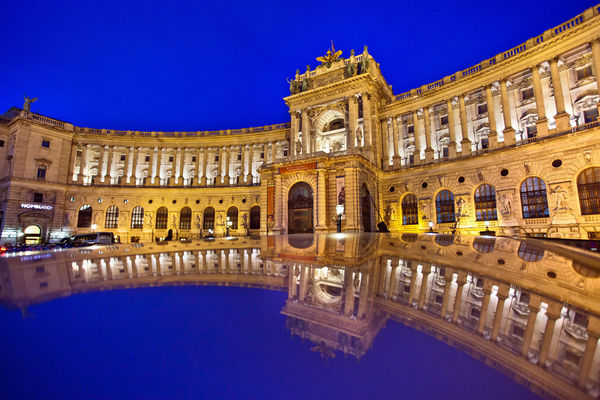The Habsburg Splendor of Vienna
By Rick Steves

In Vienna's Hofburg Palace, ground zero of the Habsburg Empire, I'm particularly entertained by its butterfly house, a tropical wonderland on the Danube. In this community of royal butterflies, the trays serving up rotting slices of banana are the tavern. Fluttery slackers lick the fermented banana juice as it beads, and then just hang out there in a stupor…or fly in giddy loop-de-loops.
While the butterflies are a quick visit, the rest of the Habsburg sights can fill an entire Vienna vacation. The lavish Imperial Apartments of the palace seem designed to give their royal residents grandeur fit for a god. After all, in the age of divine monarchs, kings and emperors such as the Habsburgs claimed that God himself had ordained them to rule with unquestioned authority.
The Habsburgs were one of a handful of royal families who ruled nearly all of Europe until World War I. Six centuries of Habsburgs ruled from Vienna, including Maria Theresa in the late 1700s. The original practitioner of "make love not war," she was famous for having 16 children and cleverly marrying many of them into the various other royal families around Europe in order to expand her empire.
Exploring the Hofburg is a treat. It's furnished as it was in the 19th century, during the reign of Maria Theresa's great-great-grandson, Emperor Franz Josef, who ruled for 68 years — nearly to the end of the empire.
Walls between the palace rooms are wide enough to hide servants' corridors. Big, ornate stoves, which servants fed from behind, heated the rooms. The decor is splendid Baroque — the preferred style of divine monarchs, as it served as a kind of propaganda to sell the Old Regime notion that some were born to rule and others were born to be ruled. The dining room is set just as it would have been. Next to each name card was a menu listing the chef responsible for each dish. (Talk about pressure.) While the Hofburg had tableware for 4,000, it'd feed 3,000 on a typical day.
Franz Josef nurtured an image of being spartan and a very hard worker. His no-frills iron bed and portable washstand are on display. (Still, it took a personal staff of 14 to make him feel properly cared for: three valets, two doormen, six manservants, and three chambermaids.) While he had a typical emperor's share of mistresses, his dresser was always well-stocked with portraits of his wife, the Empress Elisabeth ("Sisi").
Elisabeth, Franz Josef's mysterious, narcissistic, and beautiful wife, lived luxuriously in this palace — and a museum here is dedicated to her life story. It tells of her fairy-tale existence — her escapes, dieting mania, chocolate bills, and love of poetry. Her main goal in life seems to have been preserving her public image as a beauty. Peeking into her bathroom, you'll see the finest copper tub of its day resting on the first linoleum floor in Vienna, installed in 1880. Sisi has been compared to Princess Diana because of her beauty, bittersweet life, and tragic death — assassinated by an Italian anarchist in 1898. When you visit Vienna, it's easy to get caught up in the alluring legend of Empress Elizabeth.
The Habsburgs ruled as Holy Roman Emperors, and they had the fancy jewels to prove it. In the Hofburg's treasury, visitors reflect on the glitter of 21 rooms filled with precious paraphernalia, designed to help keep one royal family ruling a good part of Europe. A 500-year-old unicorn horn (or perhaps the tusk of a narwhal) was considered to have magical healing powers bestowed from on high. It was understood to confer the Holy Roman Emperor, a "divine" monarch, the grace of God — something rulers still seek today.
While the Habsburgs have been out of power since the end of World War I, they maintain a hold on the Austrian spirit — as you feel when you visit their tombs in the Kaisergruft (emperors' crypt). Stepping inside, you're surrounded by gray metal tombs festooned with Habsburg regalia. How the royals wanted to be remembered is reflected in the tombs they often helped design. Franz Josef's is an appropriately austere military tomb. Sisi always seems to get the most flowers.
While it's fun to chase down all these royal body parts, remember that the real legacy of the Habsburgs is the magnificence of their city. Stepping outside, I squint up and appreciate the brilliant, ornate skyline of Vienna.

